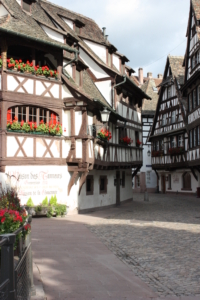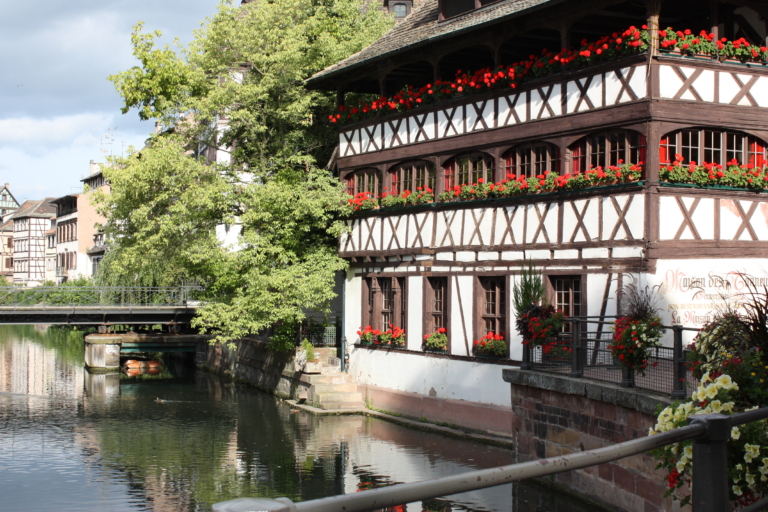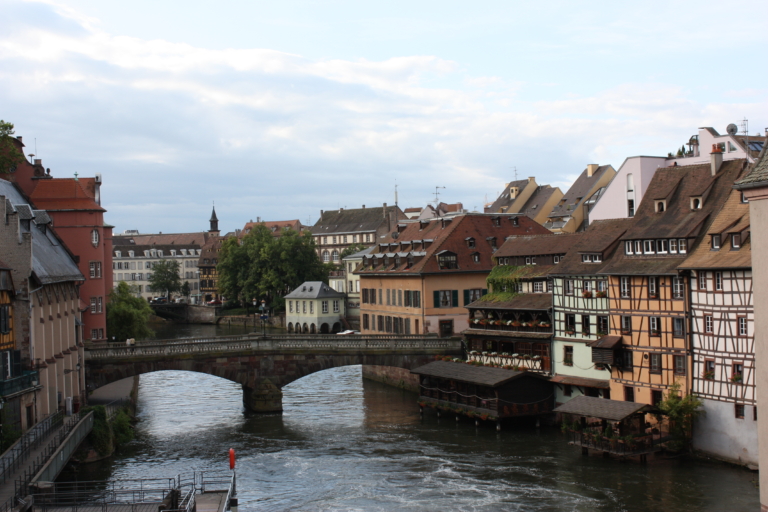Is the Study of Family History in Alsace German Genealogy or French Genealogy?
Unfortunately, there is no simple answer to the question. Genealogists have often considered the study of family history in Alsace to be part of German genealogy, based on the idea that the region was ethnically German. However, Alsace has been politically French for much of recent history. To adequately study Alsatian families, genealogists need to consider the area’s complex political and linguistic history.
The History of Alsace
Over the last three and half centuries or so, Alsace has been part of both the French and German Empires. In that period, it was under French political control for approximately 323 years and German control for approximately 51 years. Yet each country had a profound impact on the records, culture, and history of the region.
The Thirty Years War (1618-1648) laid the groundwork for French control of the region. Alsace was first annexed to France under the Treaty of Westphalia in 1648. At the time, the government of France was to obtain only the areas that were under the possession of the Habsburg monarchy. However, by 1697, the Treaty of Ryswick had established the Rhine as the political border of France, making Alsace officially French.
Yet it would fall under German control twice. In June 1871, Alsace was annexed to the German Empire as part of the peace treaty ending the Franco-Prussian War. The region rejoined France on 28 June 1919 with the Treaty of Versailles and the end of the First World War. Germany occupied the region again in 1940. Alsace was completely liberated only in March 1945.

The Languages
The initial annexation of Alsace to France placed it under a unique political structure. It had its own sovereign council and could trade freely with other countries – although it needed to pay tariffs on goods traded to other provinces. It functioned as a country within a country.
This “country within a country” status gave Alsace a measure of cultural freedom into the late 19th century. Alsace could – and did – maintain its ties to its Germanic roots. Alsatian, a German dialect, would remain the primary language of the population. The French language did gain power, but through the structures of wealth and the French government. It was employed by the upper classes, those in the military, and those who learned it through formal schooling.
The growth of nineteenth Nationalism would limit that freedom. In the late nineteenth century, France and Germany tied language into National identity. As part of the 1871 annexation, Germany not only reverted to German as the language of the State but also encouraged its use as the main language in schools. This linguistic control was not absolute: some of the former French ruling class would continue to use that language. After regaining control of Alsace in 1945, the French discouraged the use of Alsatian and treated German as a foreign language in schools. Only in the 1960s would bilingualism begin to take hold again.

What Does This Mean For Your Genealogy?
This complex history of Alsace has practical implications for genealogical research. The world in which our ancestors lived shaped what records were created and in which languages they were recorded. Today’s political and social systems impact where and how those records are stored.
Whether it was part of France or part of Germany, Alsace would have been subject to the laws and practices of that country. That means, for example, that its residents were subject to the Decree of 20 September 1792, which resulted in the creation of vital records. Similarly, after annexation in 1871, its younger men would face compulsory service in the German Army. To locate an ancestor’s records, we need to consider the laws under which they lived.
We also need to consider an ancestor’s ethnic history. An ancestor’s records would have also been shaped by their personal experiences and those of their family. To what religious denomination did they belong? What languages did they speak at home? Many families remained Protestant and spoke German at home even as the ruling class became French Catholic.
So What About The Records?
This balancing act can become apparent in the area’s records. Most early nineteenth century civil registration – birth, death, and marriage records – were kept in French. It was the political language and thus, the language of the government. Yet some records are written in German, and others indicate that the record was translated into German before it was signed. The language of the government was being balanced with the comfort level of a clerk or the need of a family to understand the records of their relatives.
While historic patterns governed the creation of our ancestor’s records, storage is determined by today’s politics. National records have largely remained with the government that created them. More local records moved with the political control of the region: today, civil registration is held by the appropriate French Departmental archive.

In Conclusion…
Is Alsatian genealogy French genealogy or German genealogy? The best answer may be that it’s both. The region was impacted not only by a German ethnic identity but also by moving political boundaries that placed it in both French and German control. Looking at the region through the lens of both fields may make it easier to understand our ancestors and their records. Best of luck in your research!

About the Author:
Bryna O’Sullivan is a Middletown, CT based professional genealogist and French to English genealogical translator. She is proprietor of Charter Oak Genealogy.
Sources:
“A Bit of History,” Mémorial Alsace Moselle (https://www.memorial-alsace-moselle.com/en/the-memorial-2/a-little-history: accessed 21 October 2022).
“Die Sprochmühle,” www.alsace-lorraine.org (https://www.alsace-lorraine.org/images/pdf/Alsacelanguage.pdf: accessed 20 October 2022).
“Histoire de la langue,” Office Pour La Langue et Les Cultures d’Alsace et de Moselle (https://www.olcalsace.org/fr/observer-et-veiller/histoire-de-la-langue: accessed 21 October 2022).
Marie-Georges Brun, “Histoire de l’Alsace,” September 2010, CRDP-Strasbourg (http://www.crdp-strasbourg.fr/data/lcr/histoire-en-bref/textes/histoire_en_bref.pdf: accessed 21 October 2022).
Sue Clarkson, “History of Alsace and Lorraine,” Foundation for Eastern European Family History Studies (https://feefhs.org/resource/germany-alsace-lorraine: accessed 21 October 2022).
“Traites,” Wipkipedia (https://fr.wikipedia.org/wiki/Traites: accessed 21 October 2022).

15 Responses
Thanks Bryna! A good overview.
In a previous guest post, I wrote about the challenges of researching genealogy in Alsace in my article about an Alsatian in New York who lost his family in the 1904 General Slocum steamboat disaster, with records about him in both French and German. In 1909 the midwife of his daughter wrote for birthplace of the parents “Elsas”!
https://germanologyunlocked.com/the-general-slocum-disaster-how-one-man-lost-his-family-and-rebuilt-his-life/
What a fascinating – and sad – story!
Thanks for the article! My ancestors lived in or near Alsace up to the early 1800’s, when they moved to the German colonies near the Black Sea. My mother still speaks some of this old dialect, but it is very different from the High German I learned in school. Relatives from the colonies wrote letters to us in the States, using Alsatian German mixed with Russian, and in the old Gothic script. It was quite the chore to translate. And when we traced our roots to near Strasbourg, the records from Alsace are generally Latin or French, with German names.
I find the mix of languages you’ll see for most families fascinating. It really provides insight into how they functioned in their day to day lives.
Thanks for this. I have a major ancestor line that I descend from who came from Alsace. I’m waiting on results of a DNA study to see if they originally came from Bern, Switzerland in the 1600-1700s. Have you heard any Alsace residence that came from there? The family surname was Stambach.
Also, I want to print this, but for some reason the first two pages the format is messed up with very large vertical letters. Any tips on printing?
I’ve not specifically seen migration from Switzerland, but it wouldn’t surprise me. I’ve seen it in Luxembourg, which was also part of France for a time. There was significant mobility in the region, especially during periods of political unrest.
Printing as a PDF first may resolve the issue.
Bryna
I think there was definitely migration from Switzerland to the southern portion of Alsace following the Thirty Years War. I have seen several examples of this in the village of Saint-Ulrich, where my Richert/Richard ancestors emigrated from in the 1830s. Before that, they and related lines (including Laemle) had been in Saint-Ulrich from about the mid-1600s, and came from Switzerland before that. The first two generations of Richert ancestors in Saint-Ulrich, Alsace, had the first name Ursus, which was the patron saint of the city of Solothurn, Switzerland. Later generations on that line favored the name Jean-Ulrich (Ulrich being the patron saint of Saint-Ulrich). My only Y-DNA match (which would be along my Richert line) , though not a close match, traces his earliest ancestor to Switzerland. 23&Me states that I have Swiss ancestry, but no French ancestry.
Please add me to your email list. I have both Alsace and Lorraine ancestors and would love to learn more!
Thank you.
Great overview. Thank you! My great-grandparents were German, and as far as I know, they lived in Germany their entire lives. However, they married in Nilvingen (Nilvange) in 1917. Thanks to the W1 Bavarian Military Records, I found that my great-grandmother’s parents lived in Nilvingen/Nilvange at the time of their marriage, which provided a likely reason for them to marry there.
The “German or French” question certainly depends on how it is asked, because when it came to obtaining the marriage record, I naturally had to learn the French laws of digital record availability and their interpretation of the CNIL. Each Department can interpret the regulation differently, and Moselle maintains a very strict interpretation, with the longest wait periods for availability through their online archive. Because of this, I was only able to obtain copies of tables that list marriages and dates by bride and groom, which include only their names, marriage date and registration number, but no personal details.
This led me to reach out to the local civil office in Nilvange, where I requested a copy of the full record via email. They were very nice and accommodating, and within a week I had a digital scan of my great-grandparents’ marriage register. Lo and behold, when I opened it, it was the standard two-page German registration Form “B” for marriages. If someone didn’t know the history of Nilvange and read this record, they would think it was simply a German record.
It was a fun exercise of exactly what you discussed. It was a bit challenging, but it was well worth it!
After many years of German research, it turns out that I have a family line with Alsatian roots. I am completely unfamiliar with the availability of records, but your post does help gain some focus.
My ancestors’ trail goes back to 1764 in Halberstadt and Derenburg in Sachsen-Anhalt. I have so far not been able to find them in area records before 1764, making me suspect that they came to Halberstadt from elsewhere. The father in this family unit was noted as Alsatian, born circa 1724. It’s unclear where his wife was from. It’s also not known where one child was born prior to 1764.
The baptisms of their children in Halberstadt and Derenburg are seemingly conflicting: two come from a Protestant church, two come from a Catholic church.
The father was a former hussar, but whether that was in Alsace or later in Sachsen-Anhalt, I do not know. By the time he was in his 50s, he had become a farmer.
Not knowing the lay of the land and without the benefit of a record that is more specific than “Alsace,” would you have any suggestions for how to proceed with this research?
Might an event have triggered emigration from Alsace between 1725 and 1760?
Any books or sites to check out?
My searches so far have not yielded any promising leads.
Dave
Can you tell me about the photos you used in the article? Where and what? Thanks
How can you cleanly print these most helpful posts?
I have a gr grandmother from Haut-Rhin near Colmar in Alsace. When I got a look at the civil records, I cringed initially because they were all in French, not German which I can speak and read nearly fluently. I looked for someone online to help me with an accurate (and genealogically-informed) translation of the French records and found someone who did a great job, but it would have been very expensive to have them do the complete run of records for these interrelated families. (I’m not suggesting that it is not worth the cost, only that I had some strict financial limits). So I’ve been waiting to see if a “godsend” would show up for me, and it did, just very recently in the form of AI.
Here’s what I did. I uploaded a nice, clean .jpg scan of the French record to transkribus.ai. I clicked on language FRENCH, and HANDWRITTEN, indicating that my record was in handwriting in the French language. I waited while Transkribus.ai then uploaded my scanned record to its server (it may take a few minutes depending on server status), and within a short time, out came a transcription of the handwritten record, still in French at this point and full of spelling errors and some unavoidable gaps in what Transkribus was able to decipher for me.
Next step – I made a copy of the Transkribus results (Ctrl C), and then went to Chat-GPT (https://chatgpt.com/). I introduced myself as a genealogist seeking help with correcting spelling errors and any missing letters in a French death record which had been preliminarily transcribed using Transkribus. Chat-GPT very kindly agreed to work with me and I pasted in the transcription (Ctrl V) into Chat-GPT. Within seconds, I had a revised and corrected transcription of the record in French.
Lastly, I then asked Chat-GPT to please translate the corrected record from French into English, and viola!, out came a nearly flawless translation — and all done within a very few minutes. I was elated and sincerely thanked Chat-GPT for the personal help. (Yes, AI does seem to respond to being treated with respect and pleasure!). Perhaps this will inspire you to try it out now too if you are stumped with a record in French from Alsace that you cannot decipher without some extra help. (As a postscript, I should add here that I used only the free, public versions of both Transkribus and Chat-GPT and it cost me nothing).
Mary thank you for such wonderful information! I look forward to trying this soon.
Cindy Hausmann
First, as a French genealogist for 30+ years, I’d like to congratulate Bryna for her brilliant and pretty comprehensive overview of this complex topic, even for French local genealogists. I would add 2 complimentary sources:
1. When Alsace was annexed by Germany in 1871, Alsatians were given the possibility of retaining French nationality subject to leaving Alsace for France. We call them “opters”.
The records are generally digitalized and a tutorial from the Bas-Rhin departmental archives describes them here:
https://archives.bas-rhin.fr/eCommunityDocuments/996A4DC5-7B41-4352-A704-F3DF616B220D/483/Fiche%20sur%20les%20optants.pdf
2. a novel and a TV serie (4 episodes) describe very well what the Alsatians experienced between 1870 and 1945, torn between two nations of which they were often of mixed blood. For those who understand French, the 4 episodes of the TV serie are on YouTube, 1st one being here: https://www.youtube.com/watch?v=bhZK876SWEA
Francois Caron